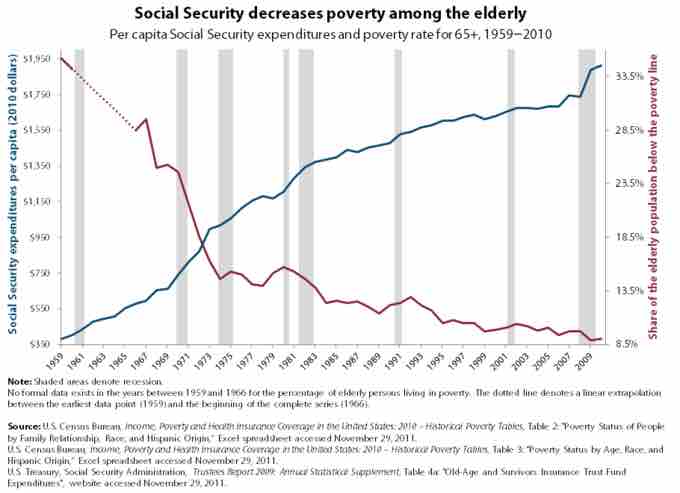Aging
As people grow older, they become less self-sufficient in terms of taking care of their own finances, health, and general day-to-day needs and obligations. For example, most societies have a generally accepted age of retirement (based on both societal norms as well as a country's tax laws and pension rules) after which point an individual ceases to engage in employment. The rest of society typically assumes some level of responsibility in ensuring that the elderly are cared for. The elderly can receive care from a variety of different sources, including their families, the state, the private sector, and charitable institutions. Nevertheless, even in societies that have a strong system in place to provide for the aged, an aging population poses a significant financial and economic burden . In the U.S. specifically, the pension system and the healthcare sector are two important examples of this problem.

Does Social Security Decrease Poverty among the Elderly?
The blue line represents social security expenditure in 2010 dollars, while the red line indicates the percentage of the population aged 65 and over who are at or below the poverty line. As the graph shows, the amount of social security expenditure is correlated with a drop in the number of elderly people at or below the poverty line.
History of Elderly Care
Traditionally, the extended family would look after the older generation. While this role is still attributed to the family in many parts of the world, particularly in non-Western nations, the modern family has evolved in such a way that care for the aged is now provided for by the state and various charitable organizations. Some of the main reasons why elders are less likely to be taken care of exclusively by their families include the decreasing size of families, the increased longevity of the elderly, the geographic dispersion of families, and the fact that women have become more educated and commonly work outside the home. While this trend is widespread in Europe and North America, there is growing evidence of it in many parts of Asia, too. The various forms that elderly care services can take include assisted living, adult day care, long-term care, nursing homes, hospice care, and in-home care. The different institutions can further be classified as medical (skilled) care and non-medical (social) care.
Several countries today are facing an aging population, where the median age of the population has increased and a larger portion of the population is considered to be older. Two primary reasons for this are increased life expectancy and lower birth rates. Currently, the majority of the countries facing this demographic phenomenon consists of advanced economies, such as Japan and many parts of Europe. However, it is predicted that the greatest future impact will occur in Asia.
Advantages of an Older Population
There may be some economic advantages to having an older population. For example, since older people have higher accumulated savings per head than younger individuals do, a large aged population can result in lower interest rates as well as a lower rate of inflation. However, for the most part, a substantial aged population leads to a lot of financial pressure on both the public and private sectors.
Disadvantages of an Older Population
One of the problems that may arise from a large segment of society being aged is a pension crisis. In the U.S., it is probably going to become increasingly difficult to pay corporate, federal, and state pensions, because the number of workers relative to retirees is shrinking. In order to improve the sustainability of the pension system, a few measures can be undertaken. For example, the worker-retiree ratio can be rectified by increasing the retirement age or by changing employment and immigration policies. Alternatively, it may be possible to reduce the amount owed to retirees. Finally, it may become necessary to expand resources to fund pensions through increased contributions or higher taxes. Trying to implement any of these solutions will likely result in some level of controversy and public debate.
Another significant source of problems related to an older population resides in the healthcare sector. In 1965, Congress created Medicare under the Social Security Act in order to provide health insurance to U.S. citizens over the age of 65, regardless of their income and medical history. Aside from premiums paid by Medicare enrollees along with the fund source itself, Medicare is financed by revenue levied on employers and workers through the Federal Insurance Contributions Act and the Self-Employment Contributions Act. However, due to rising enrollment as the population ages and a decreasing ratio of workers to enrollers, Medicare is facing financial difficulties. While the Patient Protection and Affordable Care Act is supposed to address many issues confronting the healthcare sector today, the rising cost of healthcare remains a national problem, as patients are paying more in order to receive the same care as before.